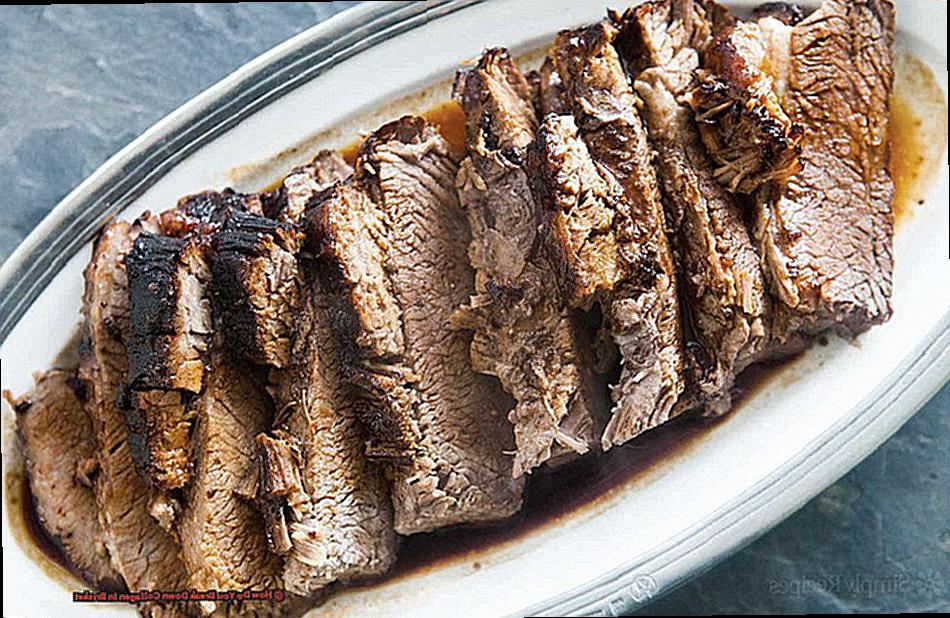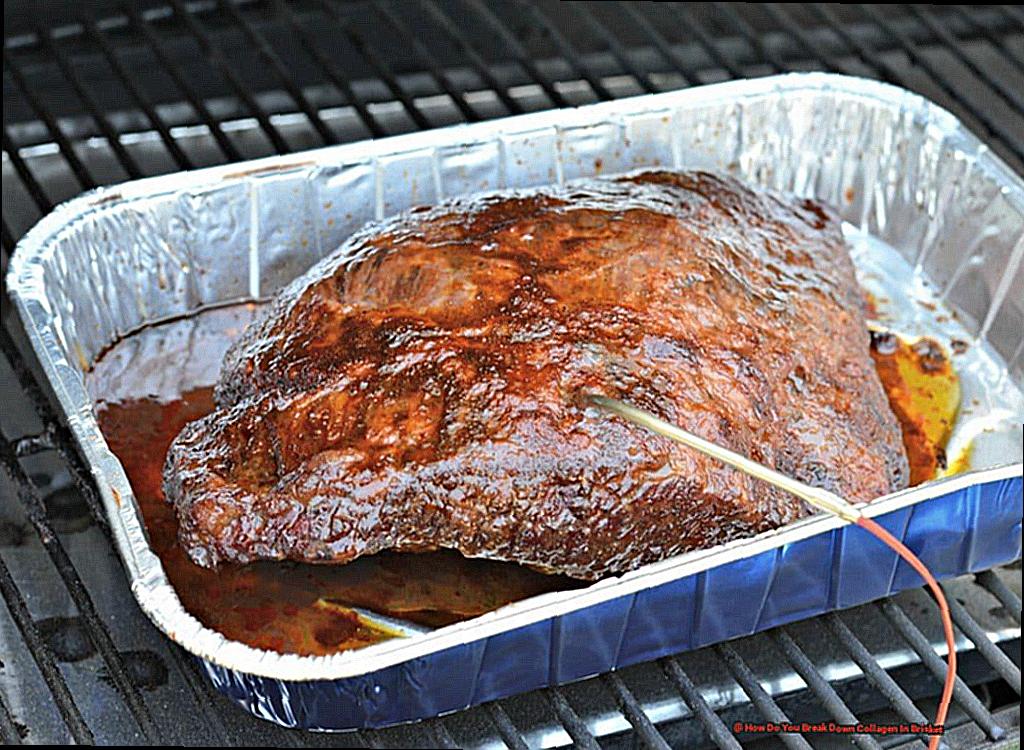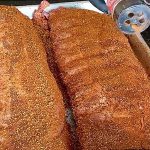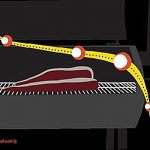Do you dream of sinking your teeth into a succulent and juicy brisket that melts in your mouth? If the answer is yes, then you’re in luck because we’re about to reveal the secret to achieving that perfect texture without sacrificing flavor. The key lies in breaking down the tough collagen fibers that hold the muscle fibers together. Collagen can transform into gelatin when exposed to heat and moisture, making it essential for creating a tender and flavorful brisket.
So, how exactly do you break down collagen in brisket? There are several methods at your disposal, including slow cooking, braising, smoking, and using tenderizing enzymes. Each approach has its own set of advantages and challenges depending on your preference and cooking style. Throughout this blog post, we’ll explore the science behind each method and provide tips and tricks to help you achieve mouth-watering brisket.
We’ll cover everything from selecting the best cut of brisket to seasoning and marinating it for maximum flavor. We’ll also dive into the nitty-gritty details of cooking it low and slow for several hours until it reaches its perfect tenderness. Whether you’re a seasoned pitmaster or a novice cook, this post will equip you with all the tools and knowledge necessary to impress your guests with a delicious brisket.
So what are you waiting for? Grab your apron, buckle up, and get ready to embark on an exciting journey into the fascinating world of breaking down collagen in brisket.
Contents
Understanding Collagen in Brisket
Collagen is the protein responsible for the structure and toughness of meat, and in brisket, it’s found in tough fibers that interweave throughout the meat.
To break down collagen in brisket, it’s crucial to understand how it behaves when cooked. The process of denaturing begins at around 160°F (71°C), causing the fibers to soften and become tender. However, this process takes time and requires a low and slow cooking method.
Cooking brisket at a low temperature for an extended period of time is key to breaking down the collagen. This typically involves cooking at around 225-250°F for 8-12 hours. During this time, collagen breaks down into gelatin, resulting in that iconic melt-in-your-mouth texture.
But wait, there’s more. Marinades or rubs can also be used to tenderize the meat further. By introducing acids or enzymes, such as those found in pineapple or papaya, they can help break down collagen fibers. Wrapping the brisket in foil or butcher paper during cooking can also help trap moisture and heat, which aids in breaking down collagen.
It’s worth noting that not all collagen will break down during cooking. Cooking at too high a temperature or for too short a time will result in tough and chewy meat. To ensure tender and delicious brisket, use a meat thermometer to confirm that the internal temperature reaches at least 160°F (71°C) and cook until it is fork-tender.
The Benefits of Breaking Down Collagen in Brisket
As an expert on the benefits of breaking down collagen in brisket, let me share with you why it’s worth taking the time to do so.
Firstly, breaking down collagen makes the meat easier to chew and enjoy. There’s nothing worse than struggling with a tough piece of meat, but by using slow cooking methods such as smoking or braising, you can achieve that melt-in-your-mouth texture that we all crave.
But it’s not just about texture – breaking down collagen also enhances the flavor of the meat. As the collagen breaks down, it releases gelatin which adds richness and depth to the flavor profile. This is what gives brisket its distinctive taste that barbecue enthusiasts love. Plus, using marinades or rubs that introduce acids or enzymes can help speed up the process of breaking down collagen.
And there’s more – breaking down collagen also has health benefits. Collagen is rich in amino acids such as glycine and proline, which have been shown to be beneficial for joint health, skin health, and gut health. By breaking down collagen during cooking, these amino acids are released into the broth or sauce, making it a nutritious addition to any meal.
In summary, here are some benefits of breaking down collagen in brisket:
- Tender and easier to chew
- More flavorful
- Healthier due to the release of amino acids

Low and Slow Cooking Method
It’s time to try the low and slow cooking method. As an expert in the art of breaking down collagen, I’m here to explain how this technique can transform even the toughest cuts of meat into mouth-watering deliciousness.
Firstly, let’s talk about collagen. Brisket contains a significant amount of this tough protein due to its heavily exercised muscles. The low and slow cooking method is the key to breaking down this collagen and achieving that melt-in-your-mouth texture we all crave.
To start, preheat your smoker or grill to a temperature of around 225-250°F. Then, season your brisket and place it on the grill, being careful not to open the lid too often as this can cause fluctuations in temperature. For the next 10-14 hours, let the heat slowly penetrate the meat and work its magic.
Maintaining a consistent temperature throughout the cooking process is crucial. You can accomplish this by using a smoker or grill with temperature control features or manually adjusting the airflow to regulate heat. This will ensure that your brisket cooks evenly without drying out.
One of the best parts of this method is that it infuses the meat with flavorful smoke, adding a unique taste to the finished product. This added depth of flavor is what sets low and slow-cooked brisket apart from other methods.
But there’s more to low and slow cooking than just flavor – it’s also beneficial for your body. The long cooking time releases amino acids that boost joint, skin, and gut health – making it not just a treat for your taste buds but also for your overall well-being.
Using Marinades or Rubs to Break Down Collagen
Brisket, the tough cut of meat that often leaves cooks scratching their heads, can be transformed into a succulent masterpiece with the right techniques. One of the most popular methods is using marinades or rubs to break down collagen, the protein responsible for its toughness.
Marinades work wonders on brisket by using acidic ingredients like vinegar or citrus juice to penetrate and break down the tough collagen fibers in the meat. However, it’s important to let the meat sit in the marinade for an appropriate amount of time, overnight if possible, to fully benefit from the acidic components. But acidic ingredients are not the only way to tenderize brisket. Enzymes such as papain found in papaya and other tenderizing ingredients like salt and sugar can be added to marinades.
Rubs are another way to enhance the flavor of meat while breaking down collagen. Rubs consist of spices and other flavorings that create a mouthwatering taste while tenderizing the meat through the use of salt and other tenderizing agents. When applying a rub to brisket, it’s essential to ensure that it fully covers the meat, and it should be done at least several hours before cooking to allow enough time for flavor penetration.
Some cooks even prefer to apply a dry rub and wrap the meat in plastic wrap overnight, allowing the flavors to permeate deep into the meat.
When using marinades or rubs, you must exercise caution when working with acidic ingredients to avoid over-tenderizing or negatively affecting the meat’s flavor. It’s also crucial to marinate or rub your meat for an appropriate amount of time so that it doesn’t end up dry or bland. With patience and experimentation, using marinades or rubs on brisket can yield a succulent and flavorful result that will leave everyone begging for seconds.
Wrapping the Brisket to Trap Moisture and Heat
Well, get ready to embark on a journey that requires patience, perseverance, and a good dose of know-how. One of the most crucial steps in cooking a brisket is wrapping it in foil or butcher paper. But why is this so important? Let me explain.
Wrapping your brisket helps to trap in moisture and heat, which is essential for breaking down the tough collagen in the meat. Collagen is a protein that makes up a large portion of the connective tissue in brisket. When cooked low and slow, it begins to break down and transform into gelatin, which gives the meat its signature tenderness and juiciness. However, this process takes time and requires a controlled cooking environment.
By wrapping your brisket, you speed up the breakdown of collagen by creating an ideal environment for it to transform into gelatin. The foil or butcher paper helps to retain moisture and heat, which means your brisket will come out juicy and tender. Plus, it protects the meat from drying out or becoming overcooked.
Timing is everything when it comes to wrapping your brisket. It’s best to wrap it at a specific point during the cooking process – typically referred to as the “stall.” This happens when the internal temperature of the meat reaches around 160-170°F. At this point, the evaporating moisture from the meat creates a cooling effect that can cause the temperature to plateau for several hours. Wrapping your brisket during this stage helps to push through the stall and continue breaking down the collagen.
So there you have it – wrapping your brisket with either foil or butcher paper is an essential step in achieving a tender and flavorful final product. Remember to do it at the right time and with either foil or butcher paper. Here are some key takeaways:
- Wrapping your brisket traps in moisture and heat, which speeds up the breakdown of collagen.
- Collagen is a tough protein that when broken down, transforms into gelatin, giving the meat its tenderness and juiciness.
- Timing is key – wrap your brisket during the stall to push through and continue breaking down the collagen.
- Wrapping with either foil or butcher paper protects the meat from drying out or becoming overcooked.
Tips for Successfully Breaking Down Collagen in Brisket
Brisket is a notoriously tough cut of meat that requires some patience and skill to make it tender and flavorful. The key to achieving this is breaking down the collagen that surrounds the muscle fibers in the brisket. Here are some tips for successfully breaking down collagen in brisket:
Choose the Right Cut
Not all briskets are created equal. Look for a brisket with plenty of marbling and a thick cap of fat. This will help keep the meat moist during cooking and provide flavor.
Season Well
A well-seasoned brisket will taste better and help break down collagen more effectively. Use a dry rub or marinade that includes salt, pepper, garlic, and other herbs and spices.
Cook Low and Slow
Brisket needs to be cooked at a low temperature (around 225-250°F) for several hours to allow the collagen to break down gradually. This can take anywhere from 8-16 hours depending on the size of the brisket.
Use a Smoker or Grill
A smoker or grill is the best way to cook brisket low and slow. The smoke flavor will also add depth and complexity to the meat.
Wrap in Foil or Butcher Paper
After several hours of cooking, wrap the brisket in foil or butcher paper to help retain moisture and speed up the cooking process.
Rest Before Slicing
Once the brisket is finished cooking, let it rest for at least 30 minutes before slicing. This allows the juices to redistribute throughout the meat, resulting in a more tender and flavorful final product.
Choosing the Right Cut
When selecting your brisket, look for one with plenty of marbling and a thick cap of fat. Marbling refers to the streaks of fat that run through the meat, which will melt during cooking and help keep it moist and flavorful. The cap of fat on top of the brisket acts as a natural basting agent, keeping the meat moist and flavorful as it cooks.
Seasoning Well
A well-seasoned brisket is essential for breaking down collagen effectively. Use a dry rub or marinade that includes salt, pepper, garlic, and other herbs and spices. The salt will help to penetrate the meat and break down the collagen, while the other seasonings will add flavor.
Cooking Low and Slow
Cooking brisket low and slow is crucial for breaking down collagen, which requires low temperatures for an extended period. This method allows the collagen to break down gradually, resulting in a tender and juicy brisket. Aim for a cooking temperature of around 225-250°F for several hours until the internal temperature of the meat reaches 195-205°F.
Using a Smoker or Grill
A smoker or grill is an excellent tool for cooking brisket low and slow. The smoke flavor from the wood adds depth and complexity to the meat while also providing a moist environment for cooking.
Common Mistakes When Breaking Down Collagen in Brisket
One of the keys to making the perfect brisket is breaking down the collagen that surrounds the muscle fibers. However, there are some common mistakes that people make when trying to achieve this, which can result in tough and chewy meat. To avoid these pitfalls and make the most tender and delicious brisket possible, consider the following tips.
Don’t rush the process
Collagen is a tough protein that surrounds the muscle fibers in brisket. In order to break it down, you need to cook the meat low and slow for several hours. One of the most common mistakes is not allowing enough time for the collagen to break down. People often get impatient and rush the cooking process, leading to tough meat. Plan ahead, give yourself plenty of time to cook your brisket, and be patient. Trust us, your taste buds will be rewarded.
Proper seasoning is crucial
Salt is essential for breaking down collagen, so it’s important to season your brisket generously before cooking. Don’t skimp on the salt or other seasonings as they enhance the flavor of the meat. A well-seasoned brisket makes all the difference between a mediocre meal and a memorable one.
Watch your liquid levels
Using too much liquid or not properly wrapping your brisket during cooking can also lead to tough meat. The liquid can dilute the flavors of your meat, and not wrapping it can cause it to dry out. To avoid this mistake, use just enough liquid to keep your brisket moist, and wrap it in foil or butcher paper to retain moisture. This will help ensure your meat stays juicy and tender.
Rest your brisket properly
Resting your brisket after cooking is critical for allowing the juices to redistribute throughout the meat, resulting in a more tender and flavorful end result. Don’t make the mistake of skipping this crucial step as it can lead to dry, tough meat. Let your brisket rest for at least 30 minutes before slicing to allow the flavors to develop and the juices to settle.
The right equipment can make all the difference
Using the wrong cooking equipment or not maintaining a consistent temperature throughout the cooking process can affect the breakdown of collagen. To avoid this mistake, use a smoker or grill that can maintain a constant low temperature for several hours. This will ensure that your brisket cooks evenly and results in perfectly tender meat.
Conclusion
In conclusion, breaking down the tough collagen in brisket is the ultimate goal for any pitmaster or home cook looking to achieve a delectable, tender brisket. The process involves understanding the science behind each cooking method and choosing the right cut of meat with ample marbling and fat.
To achieve that melt-in-your-mouth texture, one can opt for slow cooking, braising, smoking, or using tenderizing enzymes. However, it’s essential to note that collagen behaves differently when cooked, and each method requires a specific approach.
Seasoning your brisket with a dry rub or marinade that includes salt, pepper, garlic, and other herbs and spices is crucial before cooking. Low and slow cooking at around 225-250°F for several hours until the internal temperature reaches 195-205°F is recommended. Using a smoker or grill adds complexity to the meat while creating a moist environment for cooking.
Wrapping your brisket in foil or butcher paper helps trap moisture and heat during cooking. This speeds up collagen breakdown by creating an ideal environment for it to transform into gelatin. Resting your brisket after cooking is critical as it allows juices to redistribute throughout the meat.
Avoiding common mistakes like rushing the process or not maintaining consistent temperature levels during cooking is vital in achieving mouth-watering brisket that will impress your guests. Breaking down collagen not only enhances its flavor but also has health benefits due to amino acids released during cooking.






